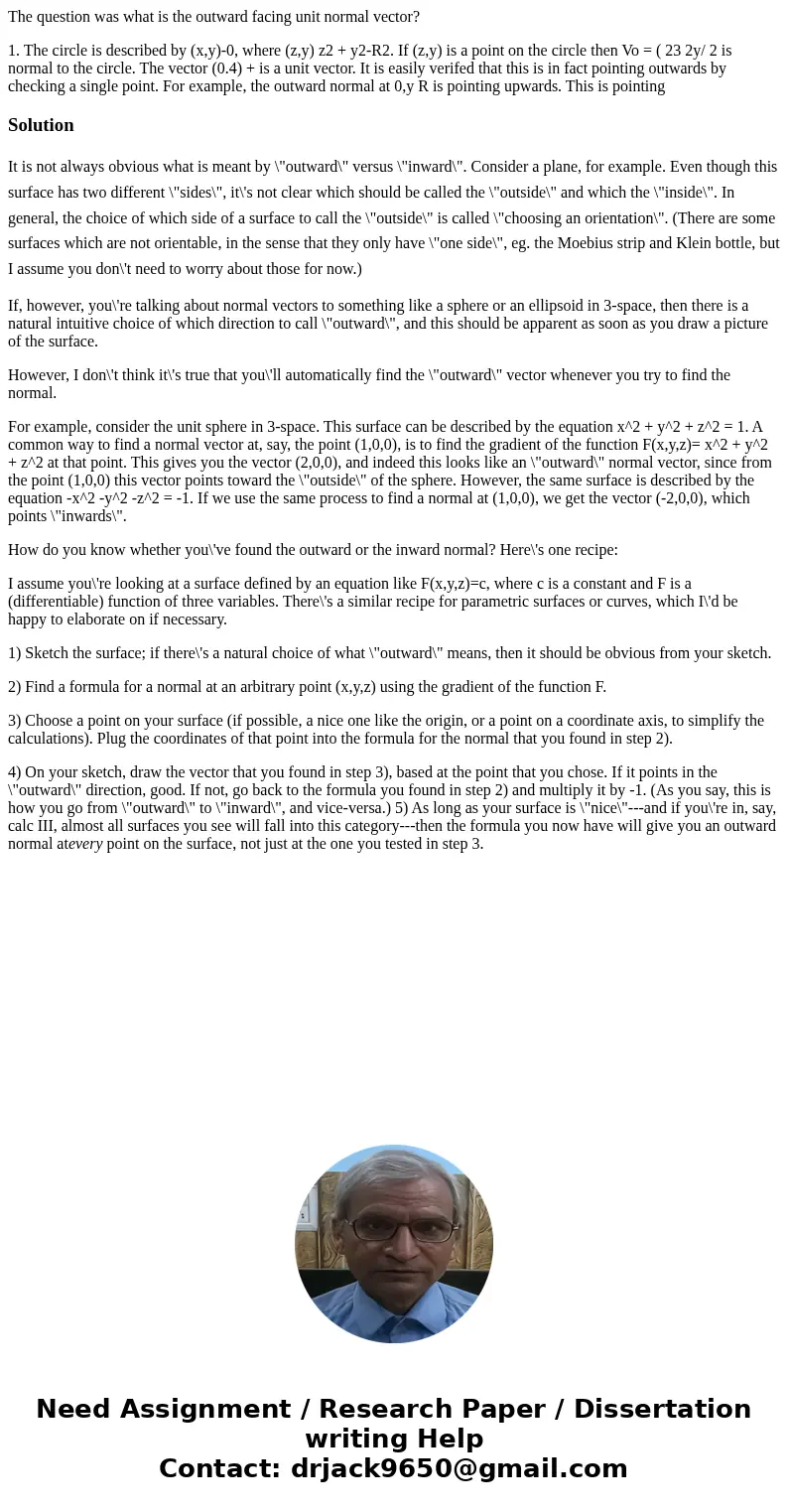The question was what is the outward facing unit normal vect
The question was what is the outward facing unit normal vector?
1. The circle is described by (x,y)-0, where (z,y) z2 + y2-R2. If (z,y) is a point on the circle then Vo = ( 23 2y/ 2 is normal to the circle. The vector (0.4) + is a unit vector. It is easily verifed that this is in fact pointing outwards by checking a single point. For example, the outward normal at 0,y R is pointing upwards. This is pointingSolution
It is not always obvious what is meant by \"outward\" versus \"inward\". Consider a plane, for example. Even though this surface has two different \"sides\", it\'s not clear which should be called the \"outside\" and which the \"inside\". In general, the choice of which side of a surface to call the \"outside\" is called \"choosing an orientation\". (There are some surfaces which are not orientable, in the sense that they only have \"one side\", eg. the Moebius strip and Klein bottle, but I assume you don\'t need to worry about those for now.)
If, however, you\'re talking about normal vectors to something like a sphere or an ellipsoid in 3-space, then there is a natural intuitive choice of which direction to call \"outward\", and this should be apparent as soon as you draw a picture of the surface.
However, I don\'t think it\'s true that you\'ll automatically find the \"outward\" vector whenever you try to find the normal.
For example, consider the unit sphere in 3-space. This surface can be described by the equation x^2 + y^2 + z^2 = 1. A common way to find a normal vector at, say, the point (1,0,0), is to find the gradient of the function F(x,y,z)= x^2 + y^2 + z^2 at that point. This gives you the vector (2,0,0), and indeed this looks like an \"outward\" normal vector, since from the point (1,0,0) this vector points toward the \"outside\" of the sphere. However, the same surface is described by the equation -x^2 -y^2 -z^2 = -1. If we use the same process to find a normal at (1,0,0), we get the vector (-2,0,0), which points \"inwards\".
How do you know whether you\'ve found the outward or the inward normal? Here\'s one recipe:
I assume you\'re looking at a surface defined by an equation like F(x,y,z)=c, where c is a constant and F is a (differentiable) function of three variables. There\'s a similar recipe for parametric surfaces or curves, which I\'d be happy to elaborate on if necessary.
1) Sketch the surface; if there\'s a natural choice of what \"outward\" means, then it should be obvious from your sketch.
2) Find a formula for a normal at an arbitrary point (x,y,z) using the gradient of the function F.
3) Choose a point on your surface (if possible, a nice one like the origin, or a point on a coordinate axis, to simplify the calculations). Plug the coordinates of that point into the formula for the normal that you found in step 2).
4) On your sketch, draw the vector that you found in step 3), based at the point that you chose. If it points in the \"outward\" direction, good. If not, go back to the formula you found in step 2) and multiply it by -1. (As you say, this is how you go from \"outward\" to \"inward\", and vice-versa.) 5) As long as your surface is \"nice\"---and if you\'re in, say, calc III, almost all surfaces you see will fall into this category---then the formula you now have will give you an outward normal atevery point on the surface, not just at the one you tested in step 3.

 Homework Sourse
Homework Sourse